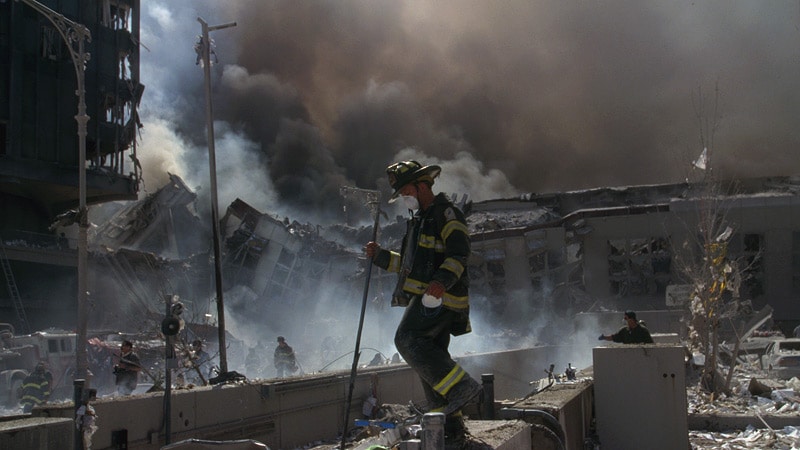Prostate Cancer Higher in 9/11 Responders: A Look at Why - Medscape

The higher incidence of prostate cancers in responders to the attacks in New York City that occurred on September 11, 2001, may be related to responders' exposure to the dust generated from the collapse of the World Trade Center (WTC) towers. This dust may have caused changes in inflammatory and immune regulatory mechanisms in prostate tissue, a new study suggests.
"Prostate cancer is one of the cancers that is significantly higher in first responders, and we wanted to understand why," said study author Emanuela Taioli, MD, PhD, director of the Institute for Translational Epidemiology at the Icahn School of Medicine at Mount Sinai and associate director for population science at the Tisch Cancer Institute, both in New York City. "For the first time, we think we have discovered the underlying mechanism."
She explained that prostate cancer tissue samples from responders showed a higher degree of expression of immunologic and inflammatory genes than tissue samples from prostate cancer tumors from persons who were not responders.
"We then looked at animal models that were exposed to WTC dust, and we saw that the same inflammatory genes were overexpressed in the prostate," she told Medscape Medical News. "We developed a hypothesis that exposure by inhalation increased the local inflammatory response in the prostate, and this process facilitated prostate cancer development."
The study results were published online January 20 in Molecular Cancer Research.
WTC dust is a complex mixture of asbestos, silica, benzene, polychlorinated biphenyls, polycyclic aromatic hydrocarbons, volatile organic compounds, and metals, the researchers explain. The presence of carcinogens and other substances that can induce inflammation raised concerns that exposure could increase the risk for cancer.
Over the years, a number of studies have examined the cancer risk of persons exposed to the debris. One study showed a higher risk for prostate cancer, cutaneous melanoma, and thyroid cancer. Another study found that environmental exposure to the WTC disaster site is associated with myeloma precursor disease and may be a risk factor for the development of multiple myeloma at an earlier age.
The incidence of prostate cancer is higher among WTC rescue and recovery workers who are included in the WTC Health Program (WTCHP) at Mount Sinai Medical Center and in a program for WTC-exposed firefighters. However, it is yet unclear whether this increased incidence is related to exposure to carcinogens in the WTC dust or is a result of surveillance bias, the researchers comment.
Paired Human and Mouse Models
In their study, Taioli and colleagues determined potential underlying mechanisms that could explain the link between the increased incidence of prostate cancer in WTC first responders.
They evaluated expression of immunologic and inflammatory genes in archived prostate cancer tumors obtained from 15 WTC responders and 14 other patients who were not responders. In the responder tumors, there was significant upregulation of genes involved in DNA damage. G2–M arrest and cell-type enrichment analysis showed that Th17 cells, a subset of proinflammatory Th cells, were specifically upregulated.
RNA-sequencing was performed on the prostates of normal rats exposed to moderate to high doses of WTC dust. The authors observed upregulation of gene transcripts of cell types involved in both adaptive immune response (dendritic cells and B cells) and inflammatory response (Th17 cells) in the prostate.
Unexpectedly, genes involved in the cholesterol biosynthesis pathway were also significantly upregulated 30 days after the rats were exposed to dust. The authors note that cholesterol serves as a precursor to steroid hormones, such as androgen, and its relationship with prostate cancer has been studied for decades. As compared with healthy prostate cells, levels of cholesterol synthesis are increased in prostate cancer.
"The other cancer that is significantly higher in responders is thyroid, and we are going to be investigating that next," said Taioli. "There may be a delayed response in other organs as well."
It would seem that the most likely malignancy to develop would be lung cancer from inhaling the WTC dust, but that hasn't been the case, at least so far. "We may be too early for lung cancer," said Taioli. "We may need to wait another 5 or 6 years."
As for prostate cancer and maybe other types of cancers, "it may first manifest as a local inflammatory response in the lungs," she added, "and then as a consequence, it stimulates an inflammatory response in the other organs."
Supports Epidemiologic Evidence
Commenting on the study, David Y. T. Chen, MD, FACS, director, Urologic Oncology Fellowship Program, Fox Chase Cancer Center, Philadelphia, Pennsylvania, explained that epidemiologic evidence has shown that WTC responders have higher rates of cancer of many types compared to people who were not involved. "The primary belief to explain the epidemiologic evidence for this has been hypothesized to be environmental exposures to toxins/carcinogens that were at elevated levels at the WTC site," he said, "and this study gives some support to that concept.
"The higher incidence of many cancers for WTC first responders would justify applying standard cancer screening recommendations," Chen noted, "and perhaps extending the surveillance beyond routine parameters, such as initiating testing at earlier ages than for the general population, and possibly continuing screening beyond the routine period as recommended for the general population."
He added that the "authors also point out that this work has larger implications to populations exposed to environmental particulates, such as emissions from motor vehicles, industrial processes, power generation, and the household combustion of solid fuel — which seems would apply to fire fighters in general."
The study was sponsored by grants from the Centers for Disease Control and Prevention and the National Institute for Occupational Safety and Health. Taioli has disclosed no relevant financial relationships. Two coauthors have relationships with industry, which are listed in the original article.
Mol Cancer Res. Published online June 20, 2019. Abstract
Follow Medscape on Facebook, Twitter, Instagram, and YouTube
https://wb.md/2YdaLSy



Comments
Post a Comment